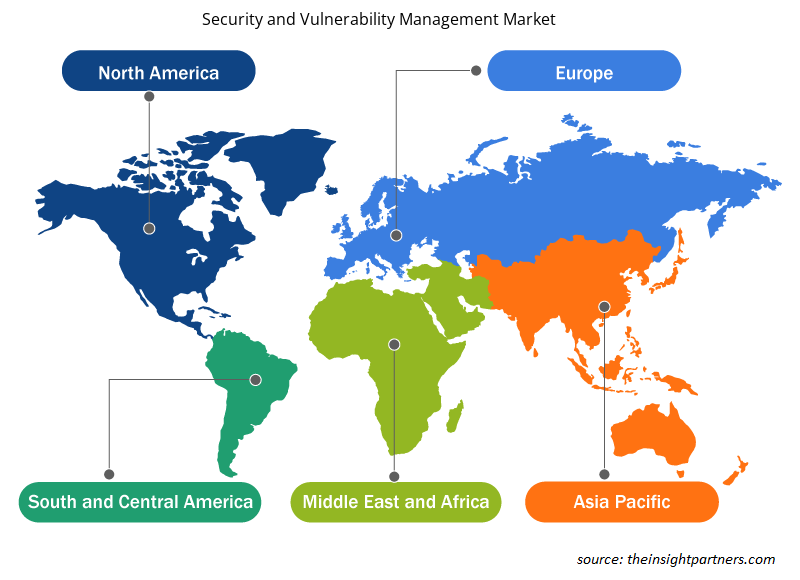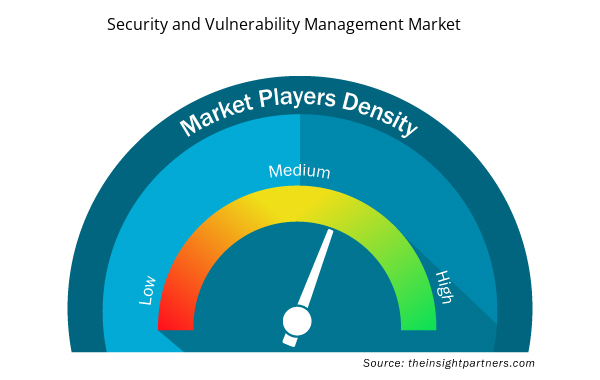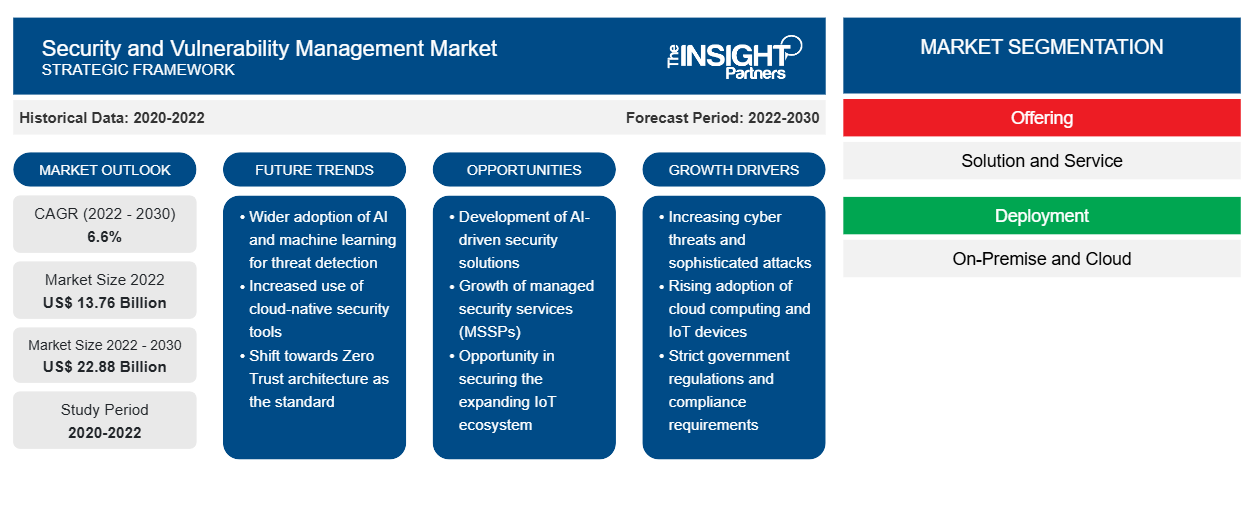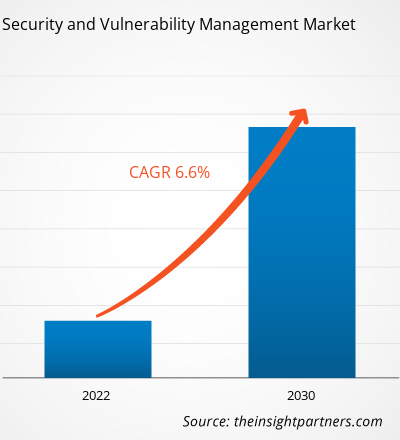[Informe de investigación] Se proyecta que el tamaño del mercado de gestión de seguridad y vulnerabilidad crecerá de US$ 13,76 mil millones en 2022 a US$ 22,88 mil millones en 2030; se estima que el mercado registrará una CAGR del 6,6% entre 2022 y 2030.
Perspectiva del analista:
El informe incluye perspectivas de crecimiento debido a las tendencias actuales del mercado de gestión de vulnerabilidades y seguridad y su impacto previsible durante el período de pronóstico. El creciente número de ciberataques e incidentes de violación de datos en todo el mundo se encuentran entre los factores que impulsan el mercado. Se espera que las crecientes inversiones en soluciones habilitadas para IA y la expansión de los sectores BFSI y de atención médica impulsen aún más el mercado durante el período de pronóstico. Las estrictas regulaciones gubernamentales relacionadas con la ciberseguridad y la confidencialidad de los datos también benefician al mercado. Además, es probable que la integración de tecnologías modernas como IA, ML, herramientas de análisis de datos y almacenamiento en la nube creen oportunidades de crecimiento para el crecimiento del mercado de gestión de vulnerabilidades y seguridad en los próximos años.
Descripción general del mercado:
La seguridad es el activo más valioso de una organización, que requiere la contribución tanto de tecnología como de capacitación. Las vulnerabilidades son causadas por fallas en los sistemas, que podrían llevar al acceso no autorizado a información privada. La gestión de la seguridad y la vulnerabilidad es el proceso de identificar, clasificar, mitigar y reparar vulnerabilidades en el hardware o software de redes. Los equipos de seguridad utilizan los datos cruciales obtenidos de la evaluación de vulnerabilidades para reparar las vulnerabilidades en sus redes, lo que facilita las actividades de evaluación de riesgos y mitigación de amenazas. Es probable que un aumento en los delitos cibernéticos y el aumento de las inversiones en procesos de ciberseguridad impulsen el crecimiento del mercado de la seguridad y la gestión de vulnerabilidades en el futuro cercano.
Personalice este informe según sus necesidades
Obtendrá personalización en cualquier informe, sin cargo, incluidas partes de este informe o análisis a nivel de país, paquete de datos de Excel, así como también grandes ofertas y descuentos para empresas emergentes y universidades.
- Obtenga las principales tendencias clave del mercado de este informe.Esta muestra GRATUITA incluirá análisis de datos, desde tendencias del mercado hasta estimaciones y pronósticos.
Impulsor del mercado de gestión de seguridad y vulnerabilidad:
El creciente número de ciberataques y violaciones de datos impulsa el mercado de la seguridad y la gestión de vulnerabilidades
Según un informe de la AAG publicado en febrero de 2024, el 43 % de las empresas del Reino Unido se enfrentan a ciberataques en 2022, lo que supone un aumento de aproximadamente el 32 % con respecto a 2020. Esto impulsa la demanda de soluciones y servicios de gestión de vulnerabilidades y seguridad entre los consumidores para proteger los datos confidenciales y los sistemas críticos contra los ciberataques. Además, estas soluciones también se utilizan para identificar y abordar vulnerabilidades que ayudan a los usuarios a mitigar los riesgos relacionados con las brechas de seguridad y proteger los datos y sistemas confidenciales.
Segmentación y alcance del informe:
El análisis del mercado de gestión de seguridad y vulnerabilidad se ha llevado a cabo teniendo en cuenta los siguientes segmentos: oferta, implementación e industria. En función de la oferta, el mercado se segmenta en soluciones y servicios. En términos de implementación, el mercado de gestión de seguridad y vulnerabilidad se clasifica en local y en la nube.Según la industria, el mercado se divide en BFSI, TI y telecomunicaciones, comercio minorista y comercio electrónico , atención médica, gobierno y servicios públicos, entre otros. Por región, el mercado está segmentado en América del Norte, Europa, Asia Pacífico (APAC), Oriente Medio y África (MEA) y América del Sur (SAM).
Análisis segmental:
Según la industria, el mercado de gestión de seguridad y vulnerabilidad está segmentado en BFSI, TI y telecomunicaciones, comercio minorista y electrónico, atención médica, gobierno y servicios públicos, y otros. Se anticipa que el segmento BFSI tendrá una participación significativa en el mercado de gestión de seguridad y vulnerabilidad durante el período de pronóstico. El crecimiento proyectado de este segmento se atribuye a la creciente digitalización y al creciente número de ciberataques en el sector BFSI, junto con su intenso impacto en las economías nacionales. Según los datos del Equipo de Respuesta a Emergencias Informáticas (CERT-In), el sector financiero en la India enfrentó más de 1,3 millones de ciberataques entre enero y octubre de 2023, con un promedio de 4400 ataques por día. La ciberseguridad se está volviendo cada vez más crucial para las instituciones financieras debido a la creciente digitalización en el sector financiero, lo que facilita la expansión del mercado de gestión de seguridad y vulnerabilidad. La digitalización facilita que los ciberatacantes ataquen sitios web y sistemas de transacciones.
Análisis regional:
El alcance geográfico del informe de mercado de gestión de vulnerabilidades y seguridad abarca América del Norte, Europa, Asia Pacífico, Oriente Medio y África, y América del Sur y Central. En términos de ingresos, América del Norte tuvo la mayor participación de mercado en gestión de vulnerabilidades y seguridad en 2022. Las crecientes inversiones en tecnología de inteligencia artificial, la creciente conciencia relacionada con las amenazas cibernéticas, las inversiones significativas en ciberseguridad y las estrictas normas y regulaciones para la industria financiera están impulsando el mercado en esta región. La región está muy centrada en la adopción de soluciones de seguridad integrales para proteger los datos de las amenazas cibernéticas. En octubre de 2023, el Comité de Asuntos Exteriores de la Cámara de Representantes y el de Seguridad Nacional y Asuntos Gubernamentales del Senado se enfrentaron a un ciberataque de piratas informáticos vietnamitas que intentaban instalar software espía en los teléfonos de los periodistas. Estos incidentes de ciberataques desencadenan la demanda de soluciones de gestión de vulnerabilidades entre los consumidores para proteger sus datos confidenciales. La gestión de vulnerabilidades permite a los usuarios fortalecer sus sistemas, proteger los datos y cumplir con los estándares de seguridad.
Análisis de los jugadores clave:
Microsoft Corp; International Business Machines Corp;, Hewlett Packard Enterprise Development LP; Qualys Inc; Tenable Holdings Inc; Rapid7; CrowdStrike Holdings Inc; Fortra, LLC; Skybox Security, Inc; y Cisco Systems Inc se encuentran entre las empresas clave perfiladas en el informe del mercado de gestión de seguridad y vulnerabilidad.
Perspectivas regionales del mercado de gestión de seguridad y vulnerabilidad
Los analistas de Insight Partners explicaron en detalle las tendencias y los factores regionales que influyen en el mercado de gestión de vulnerabilidades y seguridad durante el período de pronóstico. Esta sección también analiza los segmentos y la geografía del mercado de gestión de vulnerabilidades y seguridad en América del Norte, Europa, Asia Pacífico, Oriente Medio y África, y América del Sur y Central.

- Obtenga datos regionales específicos para el mercado de gestión de seguridad y vulnerabilidad
Alcance del informe de mercado sobre gestión de vulnerabilidades y seguridad
| Atributo del informe | Detalles |
|---|---|
| Tamaño del mercado en 2022 | US$ 13,76 mil millones |
| Tamaño del mercado en 2030 | US$ 22.88 mil millones |
| CAGR global (2022-2030) | 6,6% |
| Datos históricos | 2020-2022 |
| Período de pronóstico | 2022-2030 |
| Segmentos cubiertos | Al ofrecer
|
| Regiones y países cubiertos | América del norte
|
| Líderes del mercado y perfiles de empresas clave |
|
Densidad de actores del mercado: comprensión de su impacto en la dinámica empresarial
El mercado de gestión de vulnerabilidades y seguridad está creciendo rápidamente, impulsado por la creciente demanda de los usuarios finales debido a factores como la evolución de las preferencias de los consumidores, los avances tecnológicos y una mayor conciencia de los beneficios del producto. A medida que aumenta la demanda, las empresas amplían sus ofertas, innovan para satisfacer las necesidades de los consumidores y aprovechan las tendencias emergentes, lo que impulsa aún más el crecimiento del mercado.
La densidad de actores del mercado se refiere a la distribución de las empresas o firmas que operan dentro de un mercado o industria en particular. Indica cuántos competidores (actores del mercado) están presentes en un espacio de mercado determinado en relación con su tamaño o valor total de mercado.
Las principales empresas que operan en el mercado de gestión de seguridad y vulnerabilidades son:
- Corporación Microsoft
- Corporación Internacional de Maquinas de Negocios
- Desarrollo empresarial de Hewlett Packard LP
- Qualys Inc
- Tenable Holdings Inc
Descargo de responsabilidad : Las empresas enumeradas anteriormente no están clasificadas en ningún orden particular.

- Obtenga una descripción general de los principales actores clave del mercado de gestión de seguridad y vulnerabilidad
Desarrollos recientes:
El pronóstico del mercado de gestión de vulnerabilidades y seguridad puede ayudar a las partes interesadas en este mercado a planificar sus estrategias de crecimiento. Los actores del mercado adoptan en gran medida estrategias inorgánicas y orgánicas; a continuación se enumeran algunos de los desarrollos clave recientes:
- En octubre de 2023, BackBox Software Inc lanzó un servicio de gestión de vulnerabilidades de red para mejorar la automatización de la red. Este nuevo servicio ayuda a los usuarios en la automatización de la red y ofrece una solución integral para gestionar las vulnerabilidades dentro de las infraestructuras de red.
- En octubre de 2023, Hackuity lanzó la versión 2.0 de su plataforma inteligente de gestión de vulnerabilidades basada en riesgos. La versión 2.0 es una plataforma de última generación que presenta importantes mejoras para ayudar a las empresas a gestionar los riesgos. La nueva versión combina la gravedad de las vulnerabilidades, la inteligencia sobre amenazas y un contexto empresarial único, lo que proporciona a las empresas un puntaje de riesgo real (TRS) medible.
- En abril de 2023, Google LLC lanzó la iniciativa Hacking Policy Council para fortalecer el proceso de gestión de vulnerabilidades. Hacking Policy Council está colaborando con Intel, Bugcrowd, Intigriti, HackerOne y Luta Security para mejorar las prácticas de gestión de vulnerabilidades.
- Análisis histórico (2 años), año base, pronóstico (7 años) con CAGR
- Análisis PEST y FODA
- Tamaño del mercado Valor/volumen: global, regional, nacional
- Industria y panorama competitivo
- Conjunto de datos de Excel



Report Coverage
Revenue forecast, Company Analysis, Industry landscape, Growth factors, and Trends

Segment Covered
This text is related
to segments covered.

Regional Scope
North America, Europe, Asia Pacific, Middle East & Africa, South & Central America

Country Scope
This text is related
to country scope.
Preguntas frecuentes
Solution segment is expected to hold a major market share of security and vulnerability management market in 2022
The security and vulnerability management market is expected to register an incremental growth value of US$ 9.12 billion during the forecast period
The global market size of security and vulnerability management market by 2030 will be around US$ 22.88 billion
Stringent regulatory standards and data privacy compliances are anticipated to play a significant role in the security and vulnerability management market in the coming years.
Asia Pacific is expected to register highest CAGR in the security and vulnerability management market during the forecast period (2022-2030)
The US is expected to hold a major market share of security and vulnerability management market in 2022
Microsoft Corp; International Business Machines Corp; Hewlett Packard Enterprise Development LP; Qualys Inc; Tenable Holdings Inc; Rapid7; CrowdStrike Holdings Inc; Fortra, LLC; Skybox Security, Inc; and Cisco Systems Inc are the key market players expected to hold a major market share of security and vulnerability management market in 2022
Growing investments in AI-enabled solutions and increasing number of cyberattacks and data breaches are the major factors that propel the security and vulnerability management market.
US, China, and Japan are expected to register high growth rate during the forecast period
The estimated global market size for the security and vulnerability management market in 2022 is expected to be around US$ 13.76 billion
Trends and growth analysis reports related to Technology, Media and Telecommunications : READ MORE..
The List of Companies - Security and Vulnerability Management Market
- Microsoft Corp
- International Business Machines Corp
- Hewlett Packard Enterprise Development LP
- Qualys Inc
- Tenable Holdings Inc
- Rapid7
- CrowdStrike Holdings Inc
- Fortra, LLC
- Skybox Security, Inc
- Cisco Systems Inc
The Insight Partners performs research in 4 major stages: Data Collection & Secondary Research, Primary Research, Data Analysis and Data Triangulation & Final Review.
- Data Collection and Secondary Research:
As a market research and consulting firm operating from a decade, we have published and advised several client across the globe. First step for any study will start with an assessment of currently available data and insights from existing reports. Further, historical and current market information is collected from Investor Presentations, Annual Reports, SEC Filings, etc., and other information related to company’s performance and market positioning are gathered from Paid Databases (Factiva, Hoovers, and Reuters) and various other publications available in public domain.
Several associations trade associates, technical forums, institutes, societies and organization are accessed to gain technical as well as market related insights through their publications such as research papers, blogs and press releases related to the studies are referred to get cues about the market. Further, white papers, journals, magazines, and other news articles published in last 3 years are scrutinized and analyzed to understand the current market trends.
- Primary Research:
The primarily interview analysis comprise of data obtained from industry participants interview and answers to survey questions gathered by in-house primary team.
For primary research, interviews are conducted with industry experts/CEOs/Marketing Managers/VPs/Subject Matter Experts from both demand and supply side to get a 360-degree view of the market. The primary team conducts several interviews based on the complexity of the markets to understand the various market trends and dynamics which makes research more credible and precise.
A typical research interview fulfils the following functions:
- Provides first-hand information on the market size, market trends, growth trends, competitive landscape, and outlook
- Validates and strengthens in-house secondary research findings
- Develops the analysis team’s expertise and market understanding
Primary research involves email interactions and telephone interviews for each market, category, segment, and sub-segment across geographies. The participants who typically take part in such a process include, but are not limited to:
- Industry participants: VPs, business development managers, market intelligence managers and national sales managers
- Outside experts: Valuation experts, research analysts and key opinion leaders specializing in the electronics and semiconductor industry.
Below is the breakup of our primary respondents by company, designation, and region:

Once we receive the confirmation from primary research sources or primary respondents, we finalize the base year market estimation and forecast the data as per the macroeconomic and microeconomic factors assessed during data collection.
- Data Analysis:
Once data is validated through both secondary as well as primary respondents, we finalize the market estimations by hypothesis formulation and factor analysis at regional and country level.
- Macro-Economic Factor Analysis:
We analyse macroeconomic indicators such the gross domestic product (GDP), increase in the demand for goods and services across industries, technological advancement, regional economic growth, governmental policies, the influence of COVID-19, PEST analysis, and other aspects. This analysis aids in setting benchmarks for various nations/regions and approximating market splits. Additionally, the general trend of the aforementioned components aid in determining the market's development possibilities.
- Country Level Data:
Various factors that are especially aligned to the country are taken into account to determine the market size for a certain area and country, including the presence of vendors, such as headquarters and offices, the country's GDP, demand patterns, and industry growth. To comprehend the market dynamics for the nation, a number of growth variables, inhibitors, application areas, and current market trends are researched. The aforementioned elements aid in determining the country's overall market's growth potential.
- Company Profile:
The “Table of Contents” is formulated by listing and analyzing more than 25 - 30 companies operating in the market ecosystem across geographies. However, we profile only 10 companies as a standard practice in our syndicate reports. These 10 companies comprise leading, emerging, and regional players. Nonetheless, our analysis is not restricted to the 10 listed companies, we also analyze other companies present in the market to develop a holistic view and understand the prevailing trends. The “Company Profiles” section in the report covers key facts, business description, products & services, financial information, SWOT analysis, and key developments. The financial information presented is extracted from the annual reports and official documents of the publicly listed companies. Upon collecting the information for the sections of respective companies, we verify them via various primary sources and then compile the data in respective company profiles. The company level information helps us in deriving the base number as well as in forecasting the market size.
- Developing Base Number:
Aggregation of sales statistics (2020-2022) and macro-economic factor, and other secondary and primary research insights are utilized to arrive at base number and related market shares for 2022. The data gaps are identified in this step and relevant market data is analyzed, collected from paid primary interviews or databases. On finalizing the base year market size, forecasts are developed on the basis of macro-economic, industry and market growth factors and company level analysis.
- Data Triangulation and Final Review:
The market findings and base year market size calculations are validated from supply as well as demand side. Demand side validations are based on macro-economic factor analysis and benchmarks for respective regions and countries. In case of supply side validations, revenues of major companies are estimated (in case not available) based on industry benchmark, approximate number of employees, product portfolio, and primary interviews revenues are gathered. Further revenue from target product/service segment is assessed to avoid overshooting of market statistics. In case of heavy deviations between supply and demand side values, all thes steps are repeated to achieve synchronization.
We follow an iterative model, wherein we share our research findings with Subject Matter Experts (SME’s) and Key Opinion Leaders (KOLs) until consensus view of the market is not formulated – this model negates any drastic deviation in the opinions of experts. Only validated and universally acceptable research findings are quoted in our reports.
We have important check points that we use to validate our research findings – which we call – data triangulation, where we validate the information, we generate from secondary sources with primary interviews and then we re-validate with our internal data bases and Subject matter experts. This comprehensive model enables us to deliver high quality, reliable data in shortest possible time.


 Obtenga una muestra gratuita de este informe
Obtenga una muestra gratuita de este informe